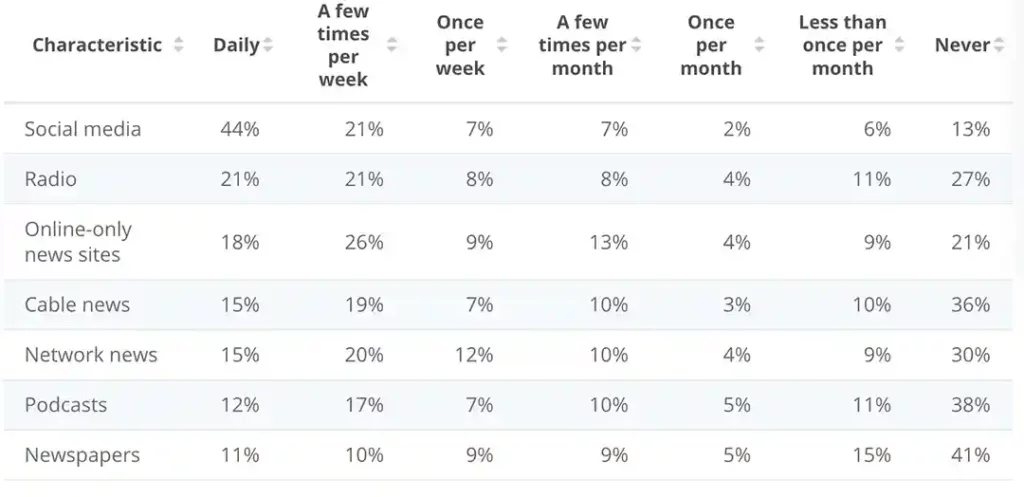What is content marketing, and why is it important?
Emily was an ambitious marketing strategist known for deeply understanding her audience. She prided herself on crafting personalized, engaging content. Her secret weapon? The empathy map—a tool she had always used to keep her finger on the pulse of her audience’s needs, emotions, and desires. But in the fast-paced world of content creation, even the most experienced professionals make mistakes.
With a big campaign launch looming, Emily found herself juggling multiple projects. She was tired and overwhelmed, so she rushed through the process when it came time to create the content plan. In her haste, she neglected her usual thoroughness. The empathy map she had meticulously developed sat untouched on her desk, gathering dust. Instead, she relied on instinct and past experiences to guide her strategy.
Weeks passed, and the campaign launched, but the results were far from what she had expected. Engagement was low, conversions were disappointing, and her audience seemed disconnected. Confused and frustrated, Emily finally revisited her empathy map. As she pored over the details, it hit her like a ton of bricks—she had overlooked critical pain points, missed emerging desires, and failed to align her content with her audience’s evolving emotional landscape.
Struggling to Keep Up with Content Demands?
In today’s digital landscape, creating consistent, high-quality content is more challenging—and more important—than ever. Without a clear plan and the right tools, your brand risks falling behind in the crowded marketplace.
Feeling defeated, Emily realized she needed help. That’s when she heard about AIContentPad, a tool that promised to generate highly personalized, data-driven content at scale. Curious but skeptical, she decided to give it a try. She fed her empathy map into the platform, allowing it to analyze the audience insights she had previously ignored.
Within minutes, AIContentPad delivered a content plan that was both precise and empathetic, addressing the very concerns and needs Emily had missed. It was as if the tool had captured the nuances she had failed to recognize in her rushed process. The content was aligned with her audience’s pain points, motivations, and emotions—everything the empathy map had highlighted but she had skipped over.
The next phase of the campaign, driven by the AI-powered content, was a massive success. Engagement soared, conversions climbed, and Emily’s connection with her audience strengthened.
Reflecting on her experience, Emily realized that AIContentPad wasn’t just a tool but a partner. It didn’t replace her empathy map—it amplified it, ensuring that no detail, emotion, or need was ever overlooked again.
In the end, Emily learned that empathy is everything in marketing. While human instincts can be fallible, AIContentPad was there to bridge the gap between intuition and precision.
I field about 10 calls per week about content marketing. The definition of content marketing varies, and a global content marketing strategy is different from a local one.
Most people think of content marketing as a process that involves buying ads, distributing flyers, or hiring a public relations firm.
While all those activities are certainly part of marketing, they’re just the tip of the iceberg. The heart and soul of marketing create content that attracts attention and engages potential customers.
Content can take many forms, including blog posts, articles, social media updates, infographics, and videos.
You should think about how your customers buy from you. What information do they need, and when? How do they consume information? Do you know what stage of the buyer journey your buyer may be at?
Your Blueprint for SEO Success in 2025
Whether you’re a business owner, marketer, or seasoned SEO professional, this guide is tailored to give you a competitive edge in the evolving digital landscape. Get SEO Pricing.
Frequency of using selected news sources among millennials in the United States
This is very interesting about news sources.

1. What is content marketing, and why is it important?

Content marketing involves creating and distributing valuable, relevant, consistent content to attract and engage a target audience. It’s one of the most effective ways to connect with customers and generate leads. Content can take many forms, including blog posts, articles, social media updates, calculators, configurations, infographics, and videos.
There are many reasons why brand journalism is important and part of the definition of content marketing. First, quality content helps to improve brand awareness. When potential customers see your business delivering valuable content, they’re more likely to trust and consider doing business with you.
Additionally, content helps create a deeper connection with customers by providing valuable information and insights. This builds trust and loyalty, leading to increased sales and conversions. Finally, brand journalism can be extremely cost-effective compared to traditional marketing methods.
If you’re not already using brand publishing, it’s time to start. It’s an essential part of any effective marketing strategy. By creating quality content, you can attract attention, build trust, and generate leads, which can help grow your business.
Our brand journalism strategy is precise and built from the consumer of information. If people don’t watch videos, will I not add resources to create them? The same goes for any other marketing tactic.
What? Do you know what your audience reads? Where?
2. What are the benefits of content marketing?

Using content marketing as part of your overall marketing strategy has several benefits.
First, quality content helps to improve brand awareness. When potential customers see your business delivering valuable content, they’re more likely to trust you and consider doing business with you.
Additionally, content helps create a deeper connection with customers by providing valuable information and insights. This builds trust and loyalty, leading to increased sales and conversions. Finally, brand publishing can be extremely cost-effective compared to traditional marketing methods.
Content That Converts: Transparent Pricing for Maximum ROI
Explore Matrix Marketing Group’s Flexible Pricing Plans for Premium Content and Marketing Solutions Tailored to Your Goals.
Some of the other benefits of content marketing include the following:
- Helps improve SEO: By creating quality content, you can help your website rank higher in search engine results pages (SERPs), driving more traffic to your site.
- Drives social media engagement: Content is a great way to get people talking about your brand on social media. Engaging and informative content encourages people to share it with their followers, which can help increase your reach and engagement.
- Increases leads and sales: By providing valuable information to potential customers, you can generate leads and convert them into paying customers.
- Helps build trust and credibility: Quality content helps establish your business as an authority in your industry. When you provide useful information that educates, entertains, or inspires people, they’re likelier to trust and do business with you.
Content marketing is a powerful tool that offers several benefits for businesses. Now is the time to start if you’re not already using it as part of your marketing strategy.
3. How do I get started with content marketing?

If you’re new to brand publishing, the first step is to create a content strategy. This will help you identify your target audience, determine what content you should create, and outline how and when you plan to share it. Some things to consider when creating your content strategy include the following:
- Your target audience: Who are you trying to reach with your content? Are they decision-makers or influencers in their industry? What are their pain points and challenges? What information do they need to decide about products or services that relate to your business?
- Goals for your content: What do you hope to achieve with your brand publishing efforts? Do you want more website traffic? More social media engagement or followers? A higher conversion rate?
- Content types: What are the different formats and content types you plan on using, such as blog posts, social media updates, infographics, videos, etc.?
What is content marketing? How will you share your content with your target audience? Will you post directly to social media or share through your website or email marketing campaigns? Which social media platforms do they use most frequently?
Once you’ve created a content strategy that aligns with your goals and targets your audience’s needs, it’s time to start creating and sharing content. This might include writing blog posts, developing infographics or other visual assets, creating videos, launching an email marketing campaign, etc.
The key is to be consistent with your content and share it regularly. Remember, the goal is to build trust and credibility with your audience, so don’t be afraid to show them who you are and your business.
If you’re unsure where to start, several content marketing resources and tools are available to help.
For example, Google allows you to research the most popular content in your industry to get ideas for your strategy.
Google Analytics can help you track the performance of your content so you can see what’s working and make necessary adjustments. Hootsuite Insights provides valuable data and insights on social media trends that can help guide your content strategy.
3. Types of content that can be used in a content marketing strategy
You can use various types and formats to reach your target audience regarding brand publishing. Below are some of the most popular types:
- Blog posts: Written content is one of the most common forms of brand publishing. A blog post can be anything from a short, 500-word article to a longer, 2,000-word piece. Remember your target audience when writing blog posts; focus on relevant and interesting topics.
- Social media updates: Social media is a great way to share your content with a wider audience. When sharing links to your blog posts or other content, use relevant hashtags and include a short description of the content. This will help increase your reach and engagement on Twitter, Facebook, and Instagram on social media platforms.
- Infographics or other visual assets: Visual content can also be a powerful tool in content marketing. Infographics are great for quickly communicating complex information in an engaging and easily digestible format. Other visual assets include videos, photos, memes, GIFs, etc.
- Ebooks and whitepapers: Long-form written content such as ebooks and whitepapers can also be valuable tools for brand publishing. These documents are typically more detailed than blog posts and often focus on a specific topic or industry issue. They can be used to educate prospects on your product or service, build trust and credibility, and generate leads.
- Case studies: Case studies are another type of long-form content that can be used for brand publishing. Typically, these stories showcase how your product or service has helped a specific customer or client achieve their desired results. Like ebooks and whitepapers, case studies are a great way to educate prospects about your business and generate leads.
- Webinars: Webinars are live or pre-recorded online events that allow you to share information with a large audience in real time. They’re typically used to provide training or educational content but can also be used as a lead-generation tool. If you plan on hosting a webinar, promote it in advance and include a call-to-action (CTA) at the end to encourage attendees to sign up for your email list or download a white paper or ebook.
- Podcasts: Podcasts are another popular form of brand journalism. They’re similar to webinars in that they’re typically used to provide educational or informational content. However, unlike webinars, podcasts can be listened to anytime and don’t require a live audience. This makes them ideal for busy professionals who want to consume content on the go. If you launch a podcast, promote it across all your social media channels and include links to your website.
Content marketing is a powerful tool to reach and engage your target audience. Using the content types listed above, you can create a strategy to help you achieve your business goals.
4. How to create quality content that engages customers

Quality content is key for marketing, as it helps to engage and connect with customers on a deeper level.
Content also helps to improve brand awareness and generate leads. By creating valuable, relevant, and consistent content, businesses can see a positive return on investment (ROI) in increased website traffic, better customer engagement, and higher conversion rates.
Unlock Your Website’s Full Potential with a SEO Fix Program
Even the best websites can struggle without robust SEO. Our $2,500 SEO Quick Fix Package is crafted for businesses that demand fast, measurable results. We start with an in-depth SEO audit to diagnose your site’s performance, then implement five targeted optimizations to boost your rankings and drive more traffic.
Several key elements go into creating quality content, including:
- High-quality research – When writing blog posts or other types of content, it’s important to research and base your writing on reliable data and sources. This will help ensure that you provide educational and accurate information to your readers. A good tip is to use a mix of primary and secondary resources when researching, as this can provide a more holistic view of the topic.
- Tailored tone – Your content should be written in a style that appeals specifically to your target audience, whether casual, professional, friendly, etc. Additionally, you should naturally incorporate keywords into your content whenever possible without overusing them. This helps improve SEO and ensure your posts are more search engine-friendly.
- Short paragraphs – When writing blog posts or other long-form content, it’s important to break up the text with short paragraphs and use eye-catching headlines. This makes it easier for readers to scan through your post and retain the information you’re providing. Additionally, shorter paragraphs help to make your writing appear more professional, as longer paragraphs can feel overwhelming for some readers.
- Engaging visuals – Good visual content such as images, charts, graphs, and videos can help attract attention from readers who are otherwise skimming over your post. Additionally, visual content makes it easier for readers to understand complex concepts and helps them retain the information longer. A good tip is to use a mix of infographics, data visualization tools such as Visme and Venngage, and stock photos to create interesting visuals that complement your written content.
Focusing on these key elements when creating your brand publishing strategy will ensure you provide high-quality material that engages and connects with customers more deeply.
5. How to measure the effectiveness of your content marketing

One of the most important aspects of any marketing strategy is measuring its effectiveness in terms of ROI. Measuring the success of your brand journalism efforts can be tricky, but there are a few key metrics that you can focus on, including:
- Website Traffic – One way to gauge the effectiveness of your content is by looking at the amount of website traffic it generates. You can use Google Analytics to track how many people visit your site and where they’re coming from (e.g., through organic search, social media, direct traffic, etc.). If you see a significant increase in website traffic after implementing a brand publishing strategy, your efforts are likely paying off.
- Social media engagement—Another metric to focus on is social media engagement, which refers to the number of likes, shares, comments, and other actions people take on your content. This can help you determine how well your posts resonate with your target audience, which can influence the types of content you create moving forward. Content marketing examples can be found all over the world.
- Lead generation – In addition to tracking website traffic and social media engagement, it’s also important to pay attention to lead generation metrics such as click-through rates (CTR), conversion rates, and open rates. These metrics will give you a more detailed look at how effectively your content generates new leads for your business. For example, if your CTR is low or you have a high bounce rate on specific site pages, this may indicate that the content isn’t resonating with your target audience, and you may need to make some changes.
By keeping a close eye on these key metrics, you can measure the effectiveness of your brand journalism strategy and make any necessary adjustments to improve results over time. The content marketing industry is constantly changing; however, the core fundamentals never do.
As long as you stay focused on providing high-quality, relevant content tailored to your target audience, you’re sure to see positive returns from your efforts in terms of increased website traffic and better conversion rates.
5. Tips for promoting your content
Once you’ve created valuable, relevant content, the next step is to promote it so that more people can see it. The types of content marketing you use depend on what and where your target audience consumes information.
Here are a few tips for getting your content in front of the right audience:
- Use social media – One of the most effective ways to promote your content is by sharing it on social media. This allows you to reach a large number of people in a short amount of time. You can share links to your blog posts or articles on Facebook, Twitter, LinkedIn, and other social media platforms. Additionally, you can use social media tools such as Hootsuite and Buffer to help automate the process.
- Submit your content to article directories and submission sites. Another great way to promote your content is submitting it to article directories and submission sites, such as Medium and HubSpot’s publishing platform. These platforms typically have a large audience to help you reach new readers. In addition, they often allow users to share your articles on social media or embed them on their websites, further extending your content’s reach.
- Work with influencers – Another effective strategy for promoting your content is leveraging the influence of other people in your industry with a large online following. You can do this by working with influencers directly (e.g., collaborating on blog posts or guest posting) or partnering with companies specializing in influencer marketing and placement programs for brands.
- Track and analyze your results—Finally, it’s important to track and analyze your efforts’ results to see what’s working and what isn’t. This will help you make necessary adjustments and improve your brand journalism strategy. You can achieve great results and grow your business by consistently creating high-quality, relevant content tailored to your target audience.
6. Measuring the success of your content marketing campaign
Measuring success is one of the most important aspects of any brand publishing campaign. This allows you to track your progress and make necessary adjustments to improve results.
There are several different ways to measure the success of your content marketing campaign, including website traffic, social media engagement, lead generation, and conversion rates.
By tracking these key metrics, you can get a more detailed look at how well your content resonates with your target audience and determine which types of content are most effective at generating leads. If you find that your website traffic is low or your conversion rates are low, this may indicate that your content needs some improvement.
However, it’s important to note that not all these metrics are equal. Website traffic, for example, can be a good indicator of the reach of your content but doesn’t necessarily tell you how many people are engaging with it. On the other hand, social media engagement is a more accurate measure of how well your content is resonating with your audience.
Lead generation and conversion rates are also important metrics to track, as they show you how effectively your content generates leads and converts them into customers or clients. If your content isn’t performing well in these areas, it may be time to change your strategy.
By tracking the right metrics, you can better understand the performance of your brand publishing campaign and make any necessary adjustments to improve your results.
7. AI and content marketing future

With the rapid advancement of artificial intelligence (AI), many experts predict that AI will play a major role in the future of content marketing. Gartner has predicted that by 2021, 85% of all customer interactions will be managed without human intervention.
So, what does this mean for content marketers? We must start preparing for a future where AI plays a major role in content creation and distribution. This could include using AI to help produce content, identify relevant trends and data, and even distribute content through social media channels.
In addition, AI could also target and personalize content for individual readers based on their interests and preferences. This would allow businesses to create a more relevant and personalized customer experience, which could help improve engagement and conversion rates.
As AI continues to grow in popularity, it’s clear that content marketers will need to start adapting to these changes by incorporating AI into their strategies to stay competitive. While the future of brand journalism is still somewhat uncertain, one thing is clear – if you want your business to succeed, you need to embrace this exciting new technology and use it to your advantage.
Overall, content marketing is important for any business looking to boost brand awareness, connect with customers deeper, and increase ROI. By creating high-quality, relevant content that resonates with your target audience and using effective distribution channels such as social media, you can help to improve your results and stay ahead of the competition. So if you haven’t already done so, it’s time to start investing in brand journalism!
Are you reading AI-written content or a copywriter? Want to know?
Conclusion
As AI technology continues to grow and evolve, it’s clear that content marketing will need to adapt to stay competitive. We define content marketing.
Businesses can prepare for the future of brand publishing by incorporating AI into their strategies. This could include using AI to help produce content, identify relevant trends and data, and even distribute content through social media channels.
Businesses can create a more personalized customer experience, increasing engagement and conversion rates.
Businesses need to start preparing for the future of brand publishing now, as this exciting new technology will play a major role in the years ahead.
How Matrix Marketing Group can help with content marketing
Matrix Marketing Group offers content marketing services, a content marketing agency that can help businesses of all sizes with their brand journalism needs. We offer various services to help you create and distribute high-quality content that will resonate with your target audience.
Our experienced professionals can help you develop a brand publishing strategy that fits your unique business needs and goals.
We can create original content for your website, blog, social media channels, and e-newsletters. We can also help you distribute your content through effective channels like search engine optimization (SEO), social media, and email marketing.
What is your content marketing strategy? What tools do you use? Here’s a resource that might help the content marketing institute.
We also offer several other services that can help you boost your brand awareness and generate leads, including web design, SEO, PPC advertising, and more. So, if you’re looking for help with your brand publishing efforts, contact Matrix Marketing Group today and show us how we can help you succeed!
Shifting from Lead Generation to Revenue Generation: A New Era for Marketing Managers
Unlocking 67% More Revenue: The Shift Every Marketing Manager Needs to Make
In today’s fast-paced digital landscape, marketing managers are bombarded with new strategies and tools claiming to revolutionize their approach. This statistic is not just a number—it’s a call to action for marketing leaders to reevaluate their strategies and realign their efforts with the bottom line. Schedule an appointment.
General FAQs
What does content marketing mean?
Content marketing is creating and distributing valuable, relevant, consistent content to attract and engage a target audience. This could include using blogs, social media, email newsletters, and other channels to share original content with your audience.
What are the benefits of content marketing?
Content marketing can help businesses improve brand awareness, connect with customers deeper, and generate leads. You can achieve these benefits by creating high-quality, relevant content that resonates with your target audience and using effective distribution channels.
How can I get started with content marketing?
There are some ways to get started with content marketing. You can start by creating a content strategy that outlines your goals and the types of content you plan to create. You can also use AI technology to help produce and distribute your content. And finally, you can use social media and other channels to share your content with your target audience.
How often should I publish new content?
There’s no one-size-fits-all answer to this question, as the frequency of new content publication will vary depending on your business and audience. However, a good rule of thumb is to publish new content regularly, whether once a week, once a month, or even daily. The key is to find a cadence that works well for you and your audience and to stick with it over time.



